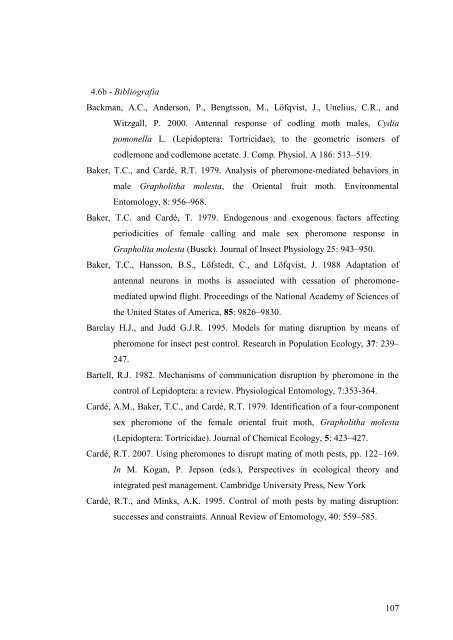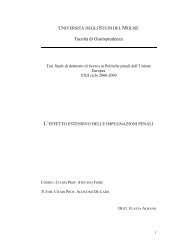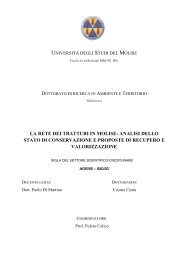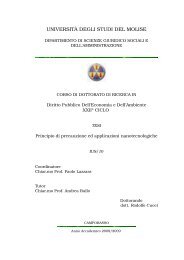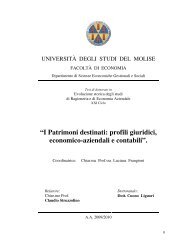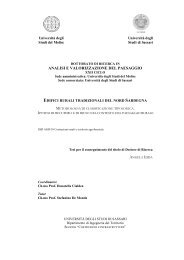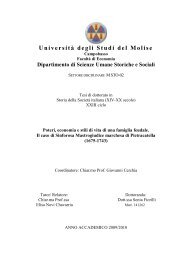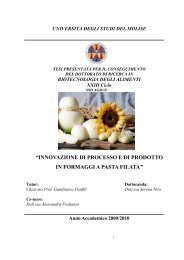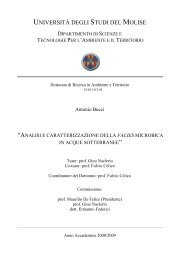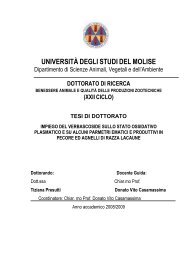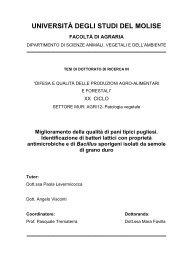UNIVERSITÀ DEGLI STUDI DEL MOLISE
UNIVERSITÀ DEGLI STUDI DEL MOLISE
UNIVERSITÀ DEGLI STUDI DEL MOLISE
Create successful ePaper yourself
Turn your PDF publications into a flip-book with our unique Google optimized e-Paper software.
4.6b - Bibliografia<br />
Backman, A.C., Anderson, P., Bengtsson, M., Löfqvist, J., Unelius, C.R., and<br />
Witzgall, P. 2000. Antennal response of codling moth males, Cydia<br />
pomonella L. (Lepidoptera: Tortricidae), to the geometric isomers of<br />
codlemone and codlemone acetate. J. Comp. Physiol. A 186: 513–519.<br />
Baker, T.C., and Cardé, R.T. 1979. Analysis of pheromone-mediated behaviors in<br />
male Grapholitha molesta, the Oriental fruit moth. Environmental<br />
Entomology, 8: 956–968.<br />
Baker, T.C. and Cardé, T. 1979. Endogenous and exogenous factors affecting<br />
periodicities of female calling and male sex pheromone response in<br />
Grapholita molesta (Busck). Journal of Insect Physiology 25: 943–950.<br />
Baker, T.C., Hansson, B.S., Löfstedt, C., and Löfqvist, J. 1988 Adaptation of<br />
antennal neurons in moths is associated with cessation of pheromone-<br />
mediated upwind flight. Proceedings of the National Academy of Sciences of<br />
the United States of America, 85: 9826–9830.<br />
Barclay H.J., and Judd G.J.R. 1995. Models for mating disruption by means of<br />
pheromone for insect pest control. Research in Population Ecology, 37: 239–<br />
247.<br />
Bartell, R.J. 1982. Mechanisms of communication disruption by pheromone in the<br />
control of Lepidoptera: a review. Physiological Entomology, 7:353-364.<br />
Cardé, A.M., Baker, T.C., and Cardé, R.T. 1979. Identification of a four-component<br />
sex pheromone of the female oriental fruit moth, Grapholitha molesta<br />
(Lepidoptera: Tortricidae). Journal of Chemical Ecology, 5: 423–427.<br />
Cardé, R.T. 2007. Using pheromones to disrupt mating of moth pests, pp. 122–169.<br />
In M. Kogan, P. Jepson (eds.), Perspectives in ecological theory and<br />
integrated pest management. Cambridge University Press, New York<br />
Cardé, R.T., and Minks, A.K. 1995. Control of moth pests by mating disruption:<br />
successes and constraints. Annual Review of Entomology, 40: 559–585.<br />
107


